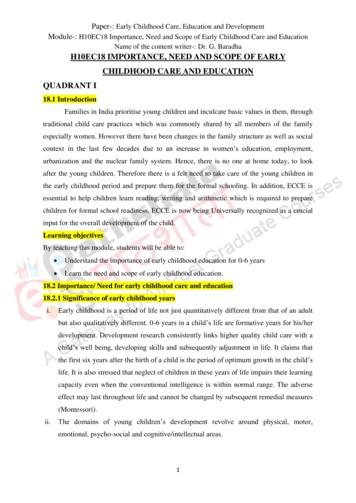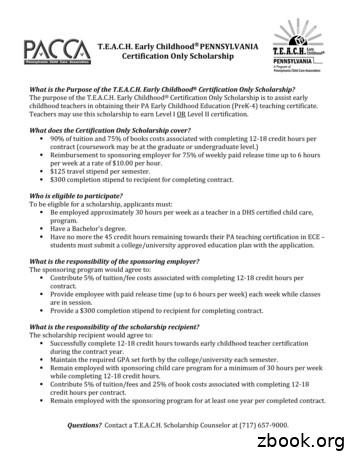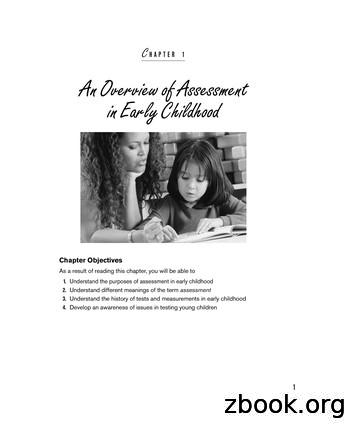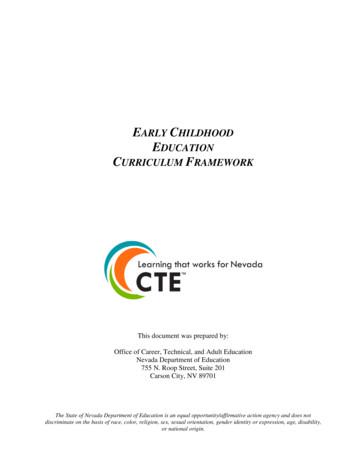Early Childhood Development And Disability
Early ChildhoodDevelopment and Disability:A discussion paper
Early ChildhoodDevelopment and Disability:A discussion paper
WHO Library Cataloguing-in-Publication DataEarly childhood development and disability: discussion paper.1.Child development. 2.Disabled children 3.Child welfare. 4.Child health services. I.World Health Organization.II.UNICEF.ISBN 978 92 4 150406 5NLM classification: WS 368) World Health Organization 2012All rights reserved. Publications of the World Health Organization are available on the WHO web site (www.who.int)or can be purchased from WHO Press, World Health Organization, 20 Avenue Appia, 1211 Geneva 27, Switzerland(tel.: 41 22 791 3264; fax: 41 22 791 4857; e-mail: bookorders@who.int).Requests for permission to reproduce or translate WHO publications – whether for sale or for noncommercialdistribution – should be addressed to WHO Press through the WHO web site (http://www.who.int/about/licensing/copyright form/en/index.html).The designations employed and the presentation of the material in this publication do not imply the expression ofany opinion whatsoever on the part of the World Health Organization concerning the legal status of any country,territory, city or area or of its authorities, or concerning the delimitation of its frontiers or boundaries. Dotted lines onmaps represent approximate border lines for which there may not yet be full agreement.The mention of specific companies or of certain manufacturers’ products does not imply that they are endorsed orrecommended by the World Health Organization in preference to others of a similar nature that are not mentioned.Errors and omissions excepted, the names of proprietary products are distinguished by initial capital letters.All reasonable precautions have been taken by the World Health Organization to verify the information contained inthis publication. However, the published material is being distributed without warranty of any kind, either expressedor implied. The responsibility for the interpretation and use of the material lies with the reader. In no event shall theWorld Health Organization be liable for damages arising from its use.Editing: Donna PhillipsCover photo: CBM/argum/Einberger (taken in Tanzania)Design and layout: Inís Communication – www.iniscommunication.comPrinted in: Malta
Contents1. Introduction 52. Children with disabilities 7What is disability and who are children with disabilities? How many children with disabilities are there? What are the rights of children with disabilities? 3. Early childhood development and disability What factors affect child development? Why support the development of children with disabilities? 4. How can we support the development of children with disabilities? Early identification of development delays and/or disabilities Assessment and planning for early intervention Service provision 788111318212222235. Conclusion and next steps: Implications for policy and programming 31References 34Early Childhood Development and Disability3
Centre for Disability in Development/ Shumon Ahmed(taken in Bangladesh)4Early Childhood Development and Disability
1. IntroductionEarly childhood is the period from prenatal development to eight years of age. It is acrucial phase of growth and development because experiences during early childhoodcan influence outcomes across the entire course of an individual’s life (1,2). For all children,early childhood provides an important window of opportunity to prepare the foundationfor life-long learning and participation, while preventing potential delays in developmentand disabilities. For children who experience disability, it is a vital time to ensure access tointerventions which can help them reach their full potential (1,3).Despite being more vulnerable to developmental risks, young children with disabilitiesare often overlooked in mainstream programmes and services designed to ensure childdevelopment (4). They also do not receive the specific supports required to meet theirrights and needs. Children with disabilities and their families are confronted by barriersincluding inadequate legislation and policies, negative attitudes, inadequate services, andlack of accessible environments (5). If children with developmental delays or disabilitiesand their families are not provided with timely and appropriate early intervention, supportand protection, their difficulties can become more severe—often leading to lifetimeconsequences, increased poverty and profound exclusion.The Convention on the Rights of the Child (CRC) (6) and the Convention on the Rights ofPersons with Disabilities (CRPD) (7) highlight how children with disabilities have the samerights as other children—for example to health care, nutrition, education, social inclusionand protection from violence, abuse and neglect. Ensuring access to appropriate support,such as early childhood intervention (ECI) and education, can fulfil the rights of childrenwith disabilities, promoting rich and fulfilling childhoods and preparing them for full andmeaningful participation in adulthood (4).This discussion paper provides a brief overview of issues pertaining to early childhooddevelopment (ECD) and disability. It lays the foundation for a long-term strategic andcollaborative process aimed at improving the developmental outcomes, participation andprotection of young children with disabilities. Essential to this effort is dialogue betweenUnited Nations agencies and relevant stakeholders to identify sustainable strategieswhich build on existing efforts, and expand on multisectoral approaches to guarantee therights of young children with disabilities and their families.Introduction5
UNICEF/NYHQ2010-0417/Holt (taken in Chad)6Early Childhood Development and Disability
2. Children with disabilitiesWhat is disability and who are children with disabilities?Our understanding of disability and who people with disabilities are has evolvedconsiderably over time.The International Classification of Functioning, Disability and Health: Children and YouthVersion (ICF-CY) regards disability as neither purely biological nor social but insteadthe interaction between health conditions and environmental and personal factors (8).Disability can occur at three levels: an impairment in body function or structure, such as a cataract which prevents thepassage of light and sensing of form, shape, and size of visual stimuli; a limitation in activity, such as the inability to read or move around; a restriction in participation, such as exclusion from school.The CRPD states that “persons with disabilities include those who have long-term physical,mental, intellectual or sensory impairments which in interaction with various barriers mayhinder their full and effective participation in society on an equal basis with others” (7).The term children with disabilities will be used throughout this paper. Some children willbe born with a disabling health condition or impairment, while others may experiencedisability as a result of illness, injury or poor nutrition. Children with disabilities includethose with health conditions such as cerebral palsy, spina bifida, muscular dystrophy,traumatic spinal cord injury, Down syndrome, and children with hearing, visual, physical,communication and intellectual impairments. A number of children have a singleimpairment while others may experience multiple impairments. For example a childwith cerebral palsy may have mobility, communication and intellectual impairments. Thecomplex interaction between a health condition or impairment and environmental andpersonal factors means that each child’s experience of disability is different.While the identification of children with developmental delay (see Box 1 on page 11 fordefinition) or disabilities is critical for the development of policies, strategic planningand service provision, it is important to acknowledge that children with disabilities rarelythink of themselves as disabled. Therefore working with children with disabilities requirescarefully tailored approaches. Labelling a child solely in terms of their health conditionshould be avoided. They are children first and aspire to participate in normal family andpeer-group activities.Children with Disabilities7
How many children with disabilities are there?WHO and the World Bank estimate that more than a billion people live with some form ofdisability, which equates to approximately 15% of the world’s population (5). Among these,between 110 million (2.2%) and 190 million (3.8%) adults have very significant difficulties infunctioning (5).There are currently no reliable and representative estimates based on actual measurementof the number of children with disabilities (9,5). Existing prevalence estimates ofchildhood disability vary considerably because of differences in definitions and the widerange of methodologies and measurement instruments adopted (5,10). The limitationsof census and general household surveys to capture childhood disability, the absence ofregistries in most low- and middle-income countries (LMICs), and poor access to culturallyappropriate clinical and diagnostic services contribute to lower estimates (10). As a resultmany children with disabilities may neither be identified nor receive needed services (5).What are the rights of children with disabilities?The CRC applies to all children in the world, including children with disabilities. It spellsout the basic human rights that children everywhere have: the right to survival; todevelop to the fullest; to protection from harmful influences, abuse and exploitation; andto participate fully in family, cultural and social life. It also recognizes the importance offamily assistance and support (6). Two articles make specific reference to children withdisabilities: Article 2 outlines the principle of non-discrimination and includes disability asgrounds for protection from discrimination; Article 23 highlights the special efforts StatesParties must make to realize these rights (6).In General Comment 9, the Committee on the Rights of the Child which oversees theimplementation of the CRC has provided guidance to States Parties in their effortsto implement the rights of children with disabilities, covering all the provisions of theConvention (11). In addition General Comment 7 (12) and General Comment 9 (11) of theCRC specifically highlight that children with disabilities: are entitled to active participationin all aspects of family and community life; require equal opportunities in order to fulfiltheir rights; and should be treated with dignity at all times. Furthermore, they statethat children with disabilities “are best cared for and nurtured within their own familyenvironment” (11) and they “should never be institutionalized solely on the grounds ofdisability” (12). States Parties must protect children with disabilities from discriminationand provide access to a range of services and supports which are specifically designed tohelp them achieve their full potential. This was reinforced in the 2010 UN General AssemblyResolution A/65/452 (13).8Early Childhood Development and Disability
Similarly, the more recent CRPD includes an article dedicated to addressing the rights ofchildren with disabilities. Article 7 outlines States Parties obligations to take measuresto ensure that children with disabilities are able to enjoy the same human rights andfundamental freedoms as other children, to consider their best interests, and to ensurethat they are able to express their view. Article 23 of the CRPD establishes the right tofamily life and Article 24 promotes the right to education (7).The CRC and the CRPD are mutually reinforcing and together provide a framework fora growing synergy between key human rights instruments. Furthermore, all initiativesintended to improve the lives of children, such as the Millennium Development Goals(MDGs) (14) apply equally and in full force to children with disabilities. Specific effortsmust be made to reach and include these children if international commitments are tobe achieved.Children with Disabilities9
UNICEF/NYHQ2011-1089/Holt (taken in Moldova)10Early Childhood Development and Disability
3. Early childhooddevelopment and disabilityChild development is a dynamic process through which children progress fromdependency on caregivers in all areas of functioning during infancy, towards growingindependence in the later childhood (primary school age), adolescence and adulthoodperiods (8,15). Skills emerge in a number of linked domains: sensory-motor, cognitive,communication and social-emotional (2,16,17). Development in each domain proceedsthrough a series of milestones or steps and typically involves mastering simple skills beforemore complex skills can be learned. It should be recognized that children play an activerole in the development of their own skills (18) and their development is also influencedby interactions within their environment (19).BOX 1: EARLY CHILDHOOD TERMINOLOGYEarly Childhood: Early childhood spans the pre-natal period to eight years of age(1). It is the most intensive period of brain development throughout the lifespan andtherefore is the most critical stage of human development. What happens beforebirth and in the first few years of life plays a vital role in health and social outcomes(20). While genetic factors play a role in shaping children’s development, evidenceindicates that the environment has a major influence during early childhood (21).Early Childhood Development: Early childhood development (ECD)1 is a genericterm that refers to a child’s cognitive, social, emotional and physical development.The same term is often used to describe a range of programmes which have the1Different terms are frequently used among different countries and stakeholders, for example EarlyChildhood Education (ECE), Early Childhood Care and Education (ECCE), Early Childhood Care (ECC), EarlyChildhood Care and Development (ECCD), and Early Childhood Care for Development.Early childhood development and disability11
ultimate goal of improving young children’s capacity to develop and learn andwhich may occur at many different levels such as child, family and community,and across different sectors such as health, education, and social protection.Developmental Delay: Developmental delay refers to children who experiencesignificant variation in the achievement of expected milestones for their actualor adjusted age (8,15). Developmental delays are measured using validateddevelopmental assessments (22) and may be mild, moderate or severe.Developmental delays are caused by poor birth outcomes, inadequate stimulation,malnutrition, chronic ill health and other organic problems, psychological andfamilial situations, or other environmental factors. While developmental delaymay not be permanent, it can provide a basis for identifying children who mayexperience a disability (8). This further emphasizes the importance of earlyidentification to commence timely interventions with family involvement, aimedat preventing delays, promoting emerging competencies and creating a morestimulating and protective environment.Early Childhood Intervention: Early childhood intervention (ECI) programmesare designed to support young children who are at risk of developmental delay,or young children who have been identified as having developmental delaysor disabilities. ECI comprises a range of services and supports to ensure andenhance children’s personal development and resilience (23), strengthen familycompetencies, and promote the social inclusion of families and children (24).Examples include specialized services such as: medical; rehabilitation (e.g. therapyand assistive devices); family-focused support (e.g. training and counselling);social and psychological; special education, along with service planning andcoordination; and assistance and support to access mainstream services such aspreschool and child-care (e.g. referral). Services can be delivered through a varietyof settings including health-care clinics, hospitals, early intervention centres,rehabilitation centres, community centres, homes and schools.12Early Childhood Development and Disability
What factors affect child development?Children’s development is influenced by a wide range of biological and environmentalfactors, some of which protect and enhance their development while others compromisetheir developmental outcomes (15). Children who experience disability early in life canbe disproportionately exposed to risk factors such as poverty; stigma and discrimination;poor caregiver interaction; institutionalization; violence, abuse and neglect; and limitedaccess to programmes and services, all of which can have a significant effect on theirsurvival and development (25,4,26,27).PovertyAlthough disability can occur in any family, poverty and disability are stronglyinterlinked: poverty may increase the likelihood of disability and may also be aconsequence of disability (5,28,29).Pregnant women living in poverty may experience poor health, restricted diet, andexposure to toxins and environmental pollutants, all of which can have a direct effect onfetal development. Children living in poverty are more likely to experience developmentaldelays than children from higher socio-economic backgrounds because they aredisproportionately exposed to a wide range of risks (15,16). These include: inadequatenutrition; poor sanitation and hygiene; exposure to infection and illness; lack of accessto health care; inadequate housing or homelessness; inadequate child care; exposure toviolence, neglect and abuse; increased maternal stress and depression; institutionalization;and inadequate stimulation (27,30).There is also evidence to suggest that children with disabilities and their families are morelikely to experience economic and social disadvantage than those without disability (5).Disability can contribute to increased poverty at the household level as parents take timeaway from income-generating activities, siblings are taken out of school to care for abrother or sister with a disability, and families are required to meet the additional costsassociated with disability, for example payments for health care and transportation (5).Early childhood development and disability13
Stigma and discriminationChildren with disabilities are among the world’s most stigmatized and excluded children(31). Limited knowledge about disability and related negative attitudes can result in themarginalization of children with disabilities within their families, schools and communities(31). In cultures where guilt, shame and fear are associated with the birth of a child witha disability they are frequently hidden from view, ill-treated and excluded from activitiesthat are crucial for their development (32). As a result of discrimination, children withdisabilities may have poor health and education outcomes; they may have low selfesteem and limited interaction with others; and they may be at higher risk for violence,abuse, neglect and exploitation (5,31).Some children with disabilities may be more vulnerable to discrimination and socialexclusion than others due to multiple disadvantages arising from impairment, age,gender or social status (32,33). Other influential factors may include geographic location(living in rural and remote areas), belonging to a minority language group and/or livingin conflict zones or areas of natural disaster. For example girls with disabilities can beparticularly at risk of being discriminated against (32) as well as children from poorerhouseholds and those from minority ethnic groups (10).Child-Parent/Caregiver interactionStimulating home environments and relationships are vital for nurturing the growth,learning and development of children (15,16). The quality of child-caregiver interactionmay be compromised when a child has a disability. Se
Early childhood development and disability11 3. Early childhood development and disability Child development is a dynamic process through which children progress from dependency on caregivers in all areas of functioning during infancy, towards growing independence in the later childhood (primary school age), adolescence and adulthood periods (8 .
Understand the importance of early childhood education for 0-6 years Learn the need and scope of early childhood education. 18.2 Importance/ Need for early childhood care and education 18.2.1 Significance of early childhood years i. Early childhood is a period of life not just quantitatively different from that of an adult
Early Childhood Care, Development and Education (ECCDE) is a term that is used interchangeably worldwide but refers to the same concept of early childhood education and cognitive development. The World Bank for instance refers to it as Early Childhood Care and Education, whereas UNESCO refers to it as Early Childhood Development Care.
T.E.A.C.H. Early Childhoodâ PENNSYLVANIA Certification Only Scholarship What is the Purpose of the T.E.A.C.H. Early Childhood Certification Only Scholarship? The purpose of the T.E.A.C.H. Early Childhood Certification Only Scholarship is to assist early childhood teachers in obtaining their PA Early Childhood Education (PreK-4) teaching certificate.
CHAPTER 1 An Overview of Assessment in Early Childhood Understanding Assessment in Infancy and Early Childhood Not too long ago, resources on early childhood assessment were limited to occa-sional articles in journals, chapters in textbooks on teaching in early childhood pro-grams, and a few small textbooks that were used as secondary texts in .
ECE 240 - Administration of Early Childhood Care and Education Programs (3) ECE 241 - Administration: Human Relations for Early Childhood Education (3) Colorado Mesa University B.A. Early Childhood Education - Early Childhood Special Education Advisor: Vail Shoultz-McCole vshoultz@coloradomesa.edu 970-255-2674
Early Childhood Education I L1 Early Childhood Education II L2 Early Childhood Education III L3C Early Childhood Education Advanced Studies AS The core course sequencing with the complementary courses provided in the following table serves as a guide to schools for their programs of study.
Development Centres ("ECDCs") under the Early Childhood Development Act and Regulations. This is an integral part of the national effort to raise the quality of early childhood programmes in Singapore. 1.3 Definition of an ECDC Section 2 of the Early Childhood Development Centres Act defines an ECDC as "any premises
A Curriculum Guide to George’s Secret Key to the Universe By Lucy & Stephen Hawking About the Book When George’s pet pig breaks through the fence into the yard next door, George meets his new neighbors—Annie and her scientist father, Eric—and discovers a secret key that opens up a whole new way of looking at the world from outer space! For Eric has the world’s most advanced computer .























